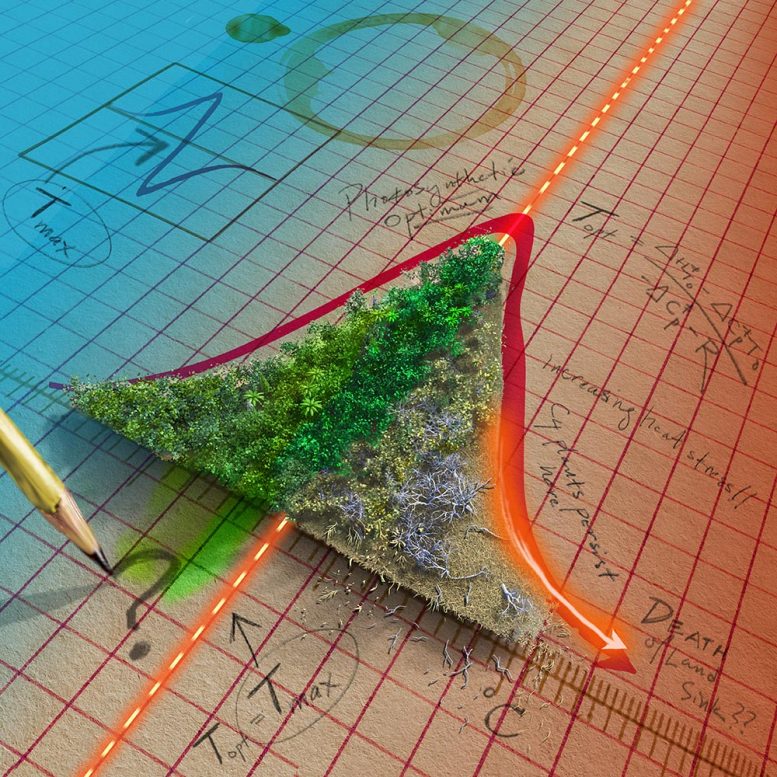
Graphic depicting the temperature tipping point at which Earth’s plants will start decreasing the amount of human-caused carbon emissions they can absorb. Credit: Victor O. Leshyk/Northern Arizona University
Earth’s ability to absorb nearly a third of human-caused carbon emissions through plants could be halved within the next two decades at the current rate of warming, according to a new study in Science Advances by researchers at Northern Arizona University, the Woodwell Climate Research Center and the University of Waikato, New Zealand. Using more than two decades of data from measurement towers in every major biome across the globe, the team identified a critical temperature tipping point beyond which plants’ ability to capture and store atmospheric carbon—a cumulative effect referred to as the “land carbon sink”—decreases as temperatures continue to rise.
The terrestrial biosphere—the activity of land plants and soil microbes—does much of Earth’s “breathing,” exchanging carbon dioxide and oxygen. Ecosystems across the globe pull in carbon dioxide through photosynthesis and release it back to the atmosphere via the respiration of microbes and plants. Over the past few decades, the biosphere has generally taken in more carbon than it has released, mitigating climate change.
But as record-breaking temperatures continue to spread across the globe, this may not continue; the NAU, Woodwell Climate, and Waikato researchers have detected a temperature threshold beyond which plant carbon uptake slows and carbon release accelerates.
Lead author Katharyn Duffy, a postdoctoral researcher at NAU, noticed sharp declines in photosynthesis above this temperature threshold in nearly every biome across the globe, even after removing other effects such as water and sunlight.
“The Earth has a steadily growing fever, and much like the human body, we know every biological process has a range of temperatures at which it performs optimally, and ones above which function deteriorates,” Duffy said. “So, we wanted to ask, how much can plants withstand?”
This study is the first to detect a temperature threshold for photosynthesis from observational data at a global scale. While temperature thresholds for photosynthesis and respiration have been studied in the lab, the Fluxnet data provide a window into what ecosystems across Earth are actually experiencing and how they are responding.
“We know that the temperature optima for humans lie around 37 degrees Celsius (98 degrees Fahrenheit), but we in the scientific community didn’t know what those optima were for the terrestrial biosphere,” Duffy said.
She teamed up with researchers at Woodwell Climate and the University of Waikato who recently developed a new approach to answer that question: MacroMolecular Rate Theory (MMRT). With its basis in the principles of thermodynamics, MMRT allowed the researchers to generate temperature curves for every major biome and the globe.
The results were alarming.
The researchers found that temperature “peaks” for carbon uptake—18 degrees C (64 degrees F) for the more widespread C3 plants and 28 degrees C (82 degrees F) for C4 plants—are already being exceeded in nature, but saw no temperature check on respiration. This means that in many biomes, continued warming will cause photosynthesis to decline while respiration rates rise exponentially, tipping the balance of ecosystems from carbon sink to carbon source and accelerating climate change.
“Different types of plants vary in the details of their temperature responses, but all show declines in photosynthesis when it gets too warm,” said NAU co-author George Koch.
Right now, less than 10 percent of the terrestrial biosphere experiences temperatures beyond this photosynthetic maximum. But at the current rate of emissions, up to half the terrestrial biosphere could experience temperatures beyond that productivity threshold by mid-century—and some of the most carbon-rich biomes in the world, including tropical rainforests in the Amazon and Southeast Asia and the Taiga in Russia and Canada, will be among the first to hit that tipping point.
“The most striking thing our analysis showed is that the temperature optima for photosynthesis in all ecosystems were so low,” said Vic Arcus, a biologist at the University of Waikato and co-author of the study. “Combined with the increased rate of ecosystem respiration across the temperatures we observed, our findings suggest that any temperature increase above 18 degrees C is potentially detrimental to the terrestrial carbon sink. Without curbing warming to remain at or below the levels established in the Paris Climate Accord, the land carbon sink will not continue to offset our emissions and buy us time.”
Reference: “How close are we to the temperature tipping point of the terrestrial biosphere?” by Katharyn A. Duffy, Christopher R. Schwalm, Vickery L. Arcus, George W. Koch, Liyin L. Liang and Louis A. Schipper, 13 January 2021, Science Advances.
DOI: 10.1126/sciadv.aay1052









Could this be in part the basis of Bill Gates threory of planning to disperse particles into our atmosphere to reflect a portion of the suns rays? Or a reflection of his ideology to cut the population in half? Or has his ideologies contributed to funding into this theory?
Quick! Notify the National Enquirer!
Another poorly done research project! For starters, most of the warming is happening at night and in the Winter, when photosynthesis is shut down. See my analysis here:
https://wattsupwiththat.com/2019/09/06/the-gestalt-of-heat-waves/
Heat waves are not becoming more frequent, nor worse than what was experienced during the 1930s.
Secondly, it isn’t just land plants that sequester CO2. Photosynthetic plankton also extract CO2, and one of the biggest sinks is cold polar water. Lastly, the amount of air-temperature increase for a doubling of CO2 is contested. For 40 years the accepted nominal value has been 3 deg C; however, more modern research has resulted in estimates of 1 to 2 deg C!
With an alarmist-believing president about to be installed, it looks like the foot soldiers are falling into formation.
Another fundamental flaw in the researcher’s analysis is that they appear to be using the monthly average temperature from the CMIP5 global circulation model. They should be using the monthly average for the daytime maximum temperature because temperatures decrease at night and photosynthesis is shut down. A more sophisticated approach would consider what percentage of the daylight hours, during the growing season, the optimal photosynthesis temperature was exceeded. The global photosynthesis curve is not symmetrical; that is, the slope approaching the optima is not the same as the slope passed the optima. For maximum daily photosynthesis, the optimal maximum temperature is different than the optimal instantaneous temperature. Because temperatures are always changing, an average daytime temperature slightly higher than the optimal photosynthesis temperature should result in maximum plant productivity, or sequestration of CO2.
However, another related problem is that it is generally acknowledged that all the models (except the Russian model) are running too warm. Until, or if, climate models become reliable, this detailed biochemical work is speculation. A chain is only as strong as its weakest link.